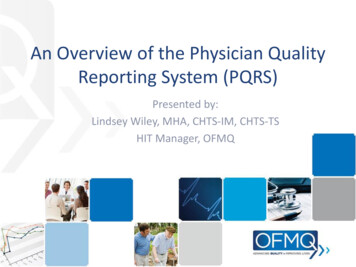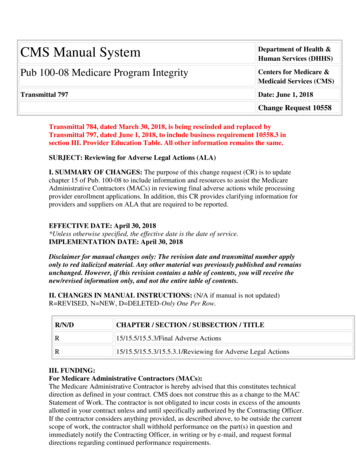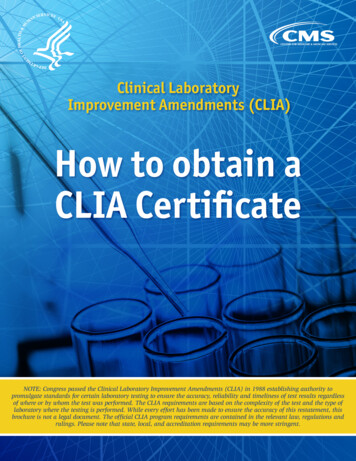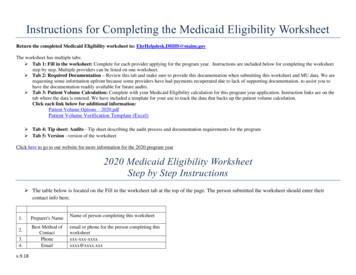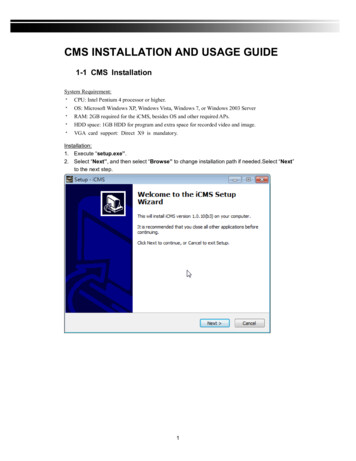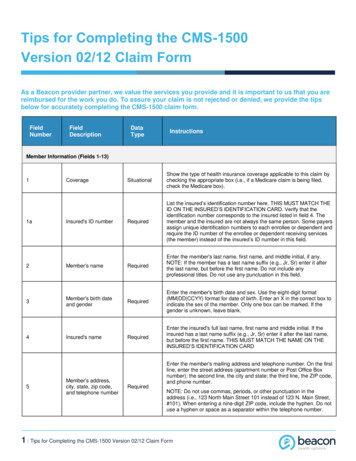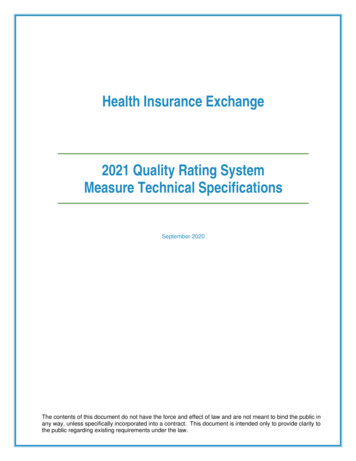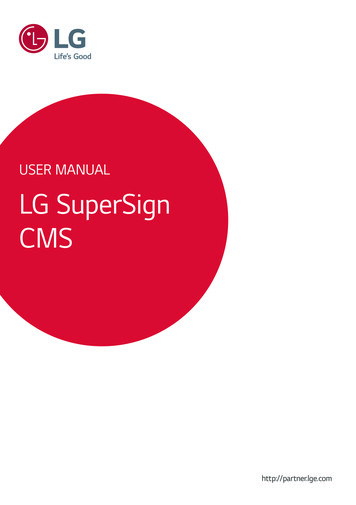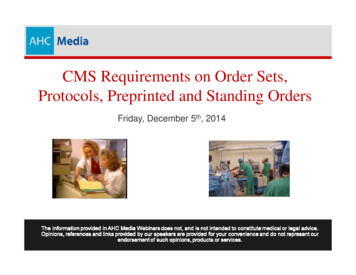
Transcription
CMS Requirements on Order Sets,Protocols, Preprinted and Standing OrdersFriday, December 5th, 2014
Speaker Sue Dill Calloway RN, Esq.CPHRM, CCMSCP AD, BA, BSN, MSN, JD President of Patient Safety andEducation Consulting Board MemberEmergency Medicine PatientSafety Foundation 614 791-1468 sdill1@columbus.rr.com2
Learning Objectives1. Recall hospital compliance requirements with the CMSCoP.2. Explain the CMS requirements for standing orders andprotocols.3. Explain new and revised standards, regulations, andlaws put forth by CMS, TJC and the federal government.4. Evaluate compliance requirements and penalties.3
You Don’t Want One of These4
The Conditions of Participation (CoPs) Many revisions since 1986 Hospital CoP Manual updated June 6, 2014 First regulations are published in the Federal Registerthen CMS publishes the Interpretive Guidelines andsome have survey procedures 2 Hospitals should check this website once a monthfor changes1 collectionCode /list.asp5
CMS Issues Final Regulation CMS publishes 165 page final regulations changingthe CMS CoP and has section on standing orders Moved standing orders to 457 in Medical Recordswhich is the primary section So now in sections 405, 406, 450, and 457 Changes effective June 7, 2013 CMS publishes to reduce the regulatory burden onhospitals-more than two dozen changes Available at www.ofr.gov/inspection.aspx6
Final IGs on Standing Orders7
Location of CMS Hospital CoP ManualNew websitewww.cms.hhs.gov/manuals/downloads/som107 Appendixtoc.pdf8
CMS Survey and Certification /list.asp#TopOfPageClick on Policy & Memos9
Access to Hospital Complaint Data CMS issued Survey and Certification memo onMarch 22, 2013 regarding access to hospitalcomplaint data Includes acute care and CAH hospitals Does not include the plan of correction but can request Questions to bettercare@cms.hhs.com This is the CMS 2567 deficiency data and lists thetag numbers Updates quarterly Available under downloads on the hospital website at www.cms.gov10
Access to Hospital Complaint Data There is a list that includes the hospital’s name andthe different tag numbers that were found to be outof compliance Many on restraints and seclusion, EMTALA, infectioncontrol, patient rights including consent, advancedirectives and grievances and standing orders Two websites by private entities also publish theCMS nursing home survey data and hospitals The ProPublica website for LTC The Association for Health Care Journalist (AHCJ)websites for hospitals11
Access to Hospital Complaint Data12
Updated Deficiency Data .html13
Deficiency Data CMS HospitalsSectionTag July 2014 April 21, 2014Administration ofDrugs/StandingOrders405 291273Standing Orders4573737Standing Orders or Drugs406 2927MR Services/Standing Orders/Date and Time of Order450 15214814
CMS Order Sets, Protocols, Standing Orders CMS has chosen not to define the differences betweenorder sets, standing orders, pre-printed orders, andprotocols However, in the March 15, 2013 memo CMS says nursesand other staff may administer drugs in accordance withpre-printed and electronic standing orders, orders andprotocols which are collectively referred to as “standingorders” and effective June 2013 These must address well defined clinical scenarios involvingmedication administration Refers to MR chapter and creates new tag 457 Moved most of standing order information in tag 405 to 457 So now look at tag numbers 405, 406, 450, and 45715
CMS Order Sets, Protocols, Standing Orders However, CMS establishes criteria anddirections on the process and policyrequirements and there are several keypoints Orders and protocols are approved by theMedical Staff in conjunction with pharmacyand nursing The orders and protocols must be consistentwith nationally recognized and evidencedbased guidelines16
What is the Difference? What is the difference between an order set,standing order and protocol.? An order set is a list of individually selectableinterventions that the ordering practitioner maychoose from Tool designed to help practitioners as they write orders An order set is an evidence based statement of bestpractice in the prevention, diagnosis, ormanagement of a given symptom, disease, orcondition for individual patients under normalcircumstances17
What is the Difference? Examples might include evidenced based ordersets (printed or electronic) for: Acute MI, CHF, or Pneumonia, CABG, stroke, asthma, ventilation weaning, Total knee replacement, total hip replacement, hipfracture, Sepsis, flu immunization It is important to know what the differentorganizations standards are such as ENA, ACEP,AORN, ASPAN, etc.18
What is the Difference? A standing order is an order (orders) that may beinitiated without an initial order by the nurse if thepatient meets certain criteria Standing orders are written documents that containorders for the patient based on various stipulatedclinical situations They usually name the condition and prescribe theaction to be taken in caring for the patient They are commonly used in ICU’s, CCUs, and theemergency department Note some hospitals use standing order and protocol interchangeable19
Standing Orders Those criteria and the resulting orders require priorapproval in policy by the medical staff Example; start an IV in the ED on a patient havingchest pain Give tetanus to patient in the ED who has not hadone in the specified period Give ACLS drugs to a patient in cardiac arrest Example: The surgery center has a preop standingorder to start an IV on all patients of 1000 cc 0.9NaCl at 25 cc an hour20
What is the Difference? A protocol also requires the patient to meet certainclinical criteria, but there must be an order to initiatethe protocol It is a step by step statement of a procedureroutinely used in the care of individual patients toassure that the intended effect is reliably achieved Example would be a heparin protocol for a patienthaving a MI in the emergency department and thephysician has ordered the same Important thing is to understand the CMS standardsfor what the hospital is doing21
What is the Difference? Pre-printed order set is a set of orders which isprinted physician orders This prevents the physicians from having to write allthe orders from memory Can be specific to a physician such as his or herorders for total knee surgery Can be pre-printed orders to reflect order setsapproved by the Medical Staff to promote bestpractices and the current evidenced based literature Has the potential to improve patient safety andoutcomes22
Preprinted Orders Vs Order Sets In some hospitals, preprinted orders weretraditionally individual physician specific Order sets replaced these traditional ones in somehospitals Order sets in some hospitals are diagnosis specificand based on published guidelines and research Order sets are implemented only by the physicianor licensed independent practitioner (LIP) or theirdelegate Insulin order set, cellulitis order set, ACS thrombolytictherapy order set, newborn circumcision order set23
Ehringer 17.pdf24
So What’s In Your Policy?25
What is the Difference? A health care guideline is an evidence-basedstatement of best practice in the prevention,diagnosis, or management of a given symptom,disease, or condition for individual patients undernormal circumstances CMS requires that standards of practice andstandards of care be entered into P&P andguidelines Examples: The CDC intravascular guidelines, CDCguidelines to prevent catheter associated UTI, CDChand hygiene guidelines, etc.26
ISMP Guidelines for Order Setswww.ismp.org/Tools/guidelines/default.asp27
28
CMS Requirements So what are the CMS requirements for order sets,protocols, pre-printed orders and standing orders? Any hospital that accepts Medicare or Medicaid must followthese for all hospital patients CMS included a section in the June 7, 2013 changes tothe Federal Register and added to tag 457 CMS has now a total four sections on standing orders;tag 405, 406, 450, and 457 Remember most of the information in tag 405 was moved to457 which was effective June 7, 2013 The development of protocols and standing orders isbest described as a journey29
Standing Orders, Protocols, Order Sets First, CMS said that a physician order was neededfirst and that standing orders had to be initiatedbefore one could implement them Hospitals argued this is not what the federal registersaid. CMS agrees and issues changes to the CoPmanual October 17, 2008 CMS issues “Standing Orders in Hospitals” memoOctober 24, 2008, S&C 12-5 It amended Tag 406 and 450 (which gets amended againJune 5, 2009, March 15, 2013 IG, and June 7, 2013)30
Standing Order st.asp#TopOfPage31
Revised Tag 405 and 40632
Tag 405 Standing Orders 2014 Most of the sections on standing orders was movedto tag 457 CMS says drugs must be administered in responseto an order from a practitioner or on the basis of astanding order The standing order must subsequently be signed offor authenticated by the practitioner This includes a date and time along with the signature The surveyor is to determine if there is a standingorder and the right medications was given to thepatient33
Tag 405 Amended in 201434
Final Transmittal Issued June 6, ransmittals/Downloads/R116SOMA.pdf35
Tag 406, 407, and CMS 2008 Memo Standard: Drugs and biologicals must be preparedon the orders contained within pre-printed andelectronic standing orders, order sets, and protocolsonly if meets the requirements of tag 457 (June 7,2013 change) Again, order can be signed by physician or practitioner(like a PharmD, NP or PA) who is allowed by state law,hospital P&P, and the Medical Staff Tag 406 requires that all orders for drugs and biologicalsmust include things like the name of the patient, date andtime of the order, weight if applicable (be sure to only getweights on children in kilograms and not pounds), drugname, dosage, frequency, etc.36
Tag 406 Flu and Pneumovac Order must be documented in the chart Reiterated that flu and pneumonia vaccinescan be administered per physician approvedhospital policy after an assessment of thecontraindications There is no requirement for the physician orother practitioner to sign or authenticate theorder The Joint Commission recognizes the sameexception37
Tag 406 Order Required Your state law sets forth the scope of practice andnot CMS and determines if the person is a LIP suchas nurse practitioners Orders may also be provide by others who areauthorized such as podiatrists, nurse practitioner,pharmacists, dentists, optometrist, chiropractor, orclinical psychologists In July 16, 2012 FR: CMS does not want to be anobstacle to what state law permits so for example ifstate allow PharmD to manage anticoagulant clinicwill allow to sign off order if done by MS approvedprotocol38
CMS Changes July 11, 2014 CMS published some final changes to hospital CoPon May 7, 2014 and in FR May 11, 2014 Says will save healthcare providers 660 millionannually and 3.2 billion over five years Several are important to the CMS dietary CoPs Reiterated about not restricting scope of practiceand deferring to the state law and state scope ofpractice Practitioner such as dietician and pharmacist canbe C&P and either a member or not a member ofthe MS39
Final Federal Register FRUpload/OFRData/2014-10687 PI.pdf40
CMS Memo on Standing Orders Oct 28, 2008 Standing orders must be documented as an order inthe patient’s chart Standing orders must later be signed off by thephysician, or other qualified practitioner, along withbeing dated and timed Went over standards for pre-printed ordersdiscussed under tag 450 All qualified practitioners responsible for the care ofthe patient and authorized by the hospital inaccordance with State law and scope of practiceare permitted to issue patient care orders41
CMS Memo on Standing Orders Oct 28, 2008 Standing orders should be evidenced based Many hospitals used protocols to standardize andoptimize patient care in accordance with clinicalguidelines or standards of practice Formal protocols may also be used with code teamor rapid response teams Pre-printed orders are a tool designed to assistqualified practitioners as they write orders Preprinted orders are allowed but must be approvedby the medical staff42
Pre-printed Orders Tag 450 This section was amended October 17, 2008and again on June 5, 2009 Note in final IG, new section adds tag 457 If a physician or LIP is using pre-printed orderset, then must comply with the below sections A preprinted order set is a tool generallydesigned to assist qualified practitioners as theywrite orders For example, an orthropedic surgeon goes to the cabinetand gets out his three page order sheets for total kneesurgery43
Pre-printed Orders Tag 450 CMS states the physician must identify the totalnumber of pages in the order set Doctor documents 3 of 3 pages Remember must sign, date and time the order If electronic medical record still need to date andtime the order and affix electronic signature The physician or practitioner must sign, date, andtime the last page of the orders also This includes initiating or signing either the top orthe bottom of the pertinent pages44
Pre-printed Orders Tag 450 This was done to prevent alterations in the medicalrecord If any additions, deletions, or strike outs are done inthe order sheet then the physician or LIP needs toinitiate to show that they made the change and notsomeone else Order sets may include computerized menu that area functional equivalent of the preprinted order set In the case of electronic orders, the physician orLIP selects the orders and then affixes an electronicsignature which includes a date and time45
Standing Orders and Protocols CMS issued more than two dozen changes thatwent into effect June 7, 2013 and added new tagnumber 457 This was first in March 15, 2013 interpretiveguideline in a CMS memo And effective on June 7, 2013 and now in current CMSmanual It was clarified that CMS is allowing for theadministration of medications and biologicals on theorders contained within preprinted and electronicstanding orders, order sets, and protocols for patientorders that meet their standards46
Order Sets, Protocols, Standing Orders CMS notes there are many situations,besides rapid response teams, wherestanding orders would be helpful This includes the emergencydepartment for things such as asthma,heart attacks, and stoke Again the ED staff would need to enterthe order in the chart and sign off theorders as discussed47
Tag 457 Added CMS C&S March 15, 201348
Tag 457 Standing Orders 2013 Standard: hospitals can use preprinted andelectronic standing orders, order sets, and protocolsfor patient orders only if the hospital has thefollowing 4 things: Make sure the orders and protocols have beenreviewed and approved by the MS (such as theMEC) and the hospital’s nursing and pharmacyleadership Demonstrate that the orders and protocols areconsistent with nationally recognized and evidencedbased guidelines49
50
Tag 457 Standing Orders 2013 Ensure that there is periodic review the standingorders conducted by MS, nursing and pharmacyleadership to determine the usefulness and safety Ensure that the standing orders are dated, timed,and authenticated by the ordering physician or otherpractitioner responsible for the care of the patient1. As long as practitioner is acting in accordance with statelaw2. Scope of practice3. Hospital P&P and4. MS bylaws and R/R51
Tag 457 Standing Orders 2013 No standard definition of standing orders For brevity CMS uses standing orders to includepre-printed orders, electronic standing orders, ordersets and protocols Said these are forms of standing orders States lack of standard definition may result inconfusion Not all preprinted and electronic order sets areconsidered a standing order covered by thisregulation52
Tag 457 Standing Orders 2013 Example; doctor or qualified practitioner picksfrom an order set menu and treatmentchoices can not be initiated by nurses orother non-practitioner staff then menus arenot standing orders covered by this regulation Menu options does not create an order setsubject to these regulations The physician has the choice not to use thismenu and could create orders from scratch ormodify it53
Tag 457 Standing Orders 2013 In cases, where a nurse can initiate without a priorspecific order, Then policy and practice must meet these regulations Doesn’t matter what it is called Must meet certain pre-defined clinical situations Emergency response or part of an evidenced-basedtreatment where it is NOT practical for a nurse to obtain awritten order or verbal order Hybrids still require compliance with this section Order set has a protocol for nurse initiated such as KCL54
Standing Order Requirements 457 Must be well-defined clinical situations withevidence to support standardized treatments Appropriate use can contribute to patient safetyand quality care Can be initiated as emergency response Can be initiated as part of an evidenced basedtreatment regime where not practicable to get awritten or verbal order Must be medically appropriate such as RRT55
Standing Order Requirements 457 Triage and initialing screening to stabilize EDpatients presenting with symptoms of MI, stroke,asthma Post-operative recovery areas like PACU Timely provisions of immunizations Can’t be used when prohibited by state or federallaw so no standing orders on R&S CMS has set forth a number of minimumrequirements for standing orders that must bepresent for a well-defined clinical scenario56
Minimum Requirements for Standing Orders Must be approved by MS, nursing and pharmacyleadership P&P address how it is developed, approved,monitored, initiated by staff and signed off orauthenticated Must have specific criteria identified in the protocolfor the order for a nurse or other staff to initiate Such as a specific clinical situation, patient condition ordiagnosis Must include process to have them signed off57
Minimum Requirements for Standing Orders Hospital must document standing order isconsistent with nationally recognized and evidencedbased guidelines Burden is on the hospital to show there is soundbasis for the standing order Must have regular review to ensure its still usefuland a safe order P&P address how to correct it, revise or modify Must be placed in the order section of the chart Must be dated, timed, and signed58
Tag 457 Standing Orders Make sure there is periodic and regular review ofthe orders and protocols conducted by the MS,nursing and pharmacy leadership to determine thecontinued usefulness and safety Make sure they are dated, timed, and authenticatedpromptly in the medical record Signed off by the ordering practitioner of anotherpractitioner on the case Could be signed off by non-physician if allowed byhospital policy, state law, the person state law scopeof practice, and MS bylaws or R/R59
Subq Insulin Order n QI Clinical Tools&Template /CM/HTMLDisplay.cfm&ContentID 423960
Insulin Drip Protocol61
Alcohol Withdrawal Treatment Protocol62
Guidelines www.guidelines.gov63
Joint Commission Standards on Protocols,Standing Orders and Order SetsWhat Hospitals Need to Know64
Joint Commission Standards MM.04.01.01 No definition of standing order, protocol, ororder set in the glossary However, MM.04.01.01 EP1 defines standing order Standing orders: A pre-written medication order and specificinstructions from the licensed independentpractitioner (LIP) to administer a medication to aperson in clearly defined circumstances65
Joint Commission Standards MM.04.01.01 Added MM.04.01.01, EP 15, effective September 1,2012 regarding pre-printed and standing orders To bring TJC standards into compliance with CMSchanges that went into effect June 7, 2013 Standard: Medication orders are clear and accurate For hospitals that use TJC for deemed status (DS) Processes for the use of pre-printed and electronicstanding orders, order sets, and protocols formedications orders must include the following:66
TJC Standing Orders, Order Sets MM.04.01.01 The Medical Staff (MS), Nursing and Pharmacyneed to review and approve all standing orders andprotocols The hospital must evaluate standing orders andprotocols to ensure they are consistent withnationally recognized and evidence basedguidelines There must be a regular review of standing ordersand protocols by MS, Nursing, and Pharmacy todetermine their continued usefulness and safety67
TJC Standing Orders, Order Sets MM.04.01.01 Standing orders and protocols Must be dated and timed Must be signed off or authenticated by theordering practitioner or a practitioner responsiblefor the patient’s care Must be in accordance with professionalstandards of practice, and law and regulation Must be consistent with hospital policies andprocedures and MS bylaws and rules ®ulations68
MM.02.01.01 Hospital Selects Medications Standard: The hospital selects and obtainsmedications Recently, hospitals have experienced manyproblems related to drug shortages and outages EP 12 States that’s the hospitals develops andapproves written medication substitutionprotocols to be use in the event of a medicationshortage or outage EP 13 States hospital must implement its approvedmedication substitution protocols69
MM.02.01.01 Medication Substitution Protocol EP14 Hospital needs to have a process tocommunicate to the physicians and LIPs and staffabout the medication substitute protocol forshortages and outages EP 15 Hospital implements its process tocommunicate to all of the above who participate inmedication management about the medicationsubstitution protocols for shortages and outages Hospitals can sign up to get email updates on drugshortages and outages from the FDA ASHP also has good resources on the same70
.htm71
Email Updates on Drug SFDA/subscriber/new?pop t&topic id USFDA 2272
ASHP Drug Shortages Resourceshttp://www.ashp.org/shortages73
ASHP Resources on Managing74
NPSG.03.05.01 AnticoagulantProtocols Standard: Reduce the likelihood of patient harmassociated with anticoagulant therapy This standard applies to hospitals that provideanticoagulant therapy or long term prophylaxis forthings like atrial fibrillation where it is expected labelvalues will remain outside normal values Does not apply to short term use to prevent DVTs EP2 Hospitals must use approved protocolsfor the initiation and maintenance ofanticoagulant therapy75
University of Washington Anticoagulationhttp://www.uwmcacc.org/76
Heparin Protocol77
Other Sections Mentioning Protocols MM.05.01.01 A pharmacist reviews theappropriateness of all medication orders to bedispensed in the hospital EP1 An exception to the rule is if the medication delaywould harm the patient The radiology department is expected to define through aprotocol or a policy the role of the LIP in the directsupervision of a patient during and after IV contrast MM.06.01.05 Must have written process for use ofinvestigational medication that specifies if patientinvolved in investigational proctocol78
Other Sections Mentioning Protocols NPSG.07.04.01 Related to central line associatedbloodstream infections Need standardized protocol and checklist Need standardized protocol for sterile barrierprecautions Use standardized protocol to disinfect catheter hubs andinjection ports PC.01.02.15 Hospitals in California must makesure dose of CT scan is recorded in the medicalrecord or on the protocol page that lists theradiation dose79
The End! Questions? Sue Dill Calloway RN, Esq.CPHRM, CCMSCP AD, BA, BSN, MSN, JD President of Patient Safety andEducation Consulting Board MemberEmergency MedicinePatient Safety Foundation 614 791-1468 sdill1@columbus.rr.com(Call with Questions, No emails)80
CHA Guidelines and Standing Orders The California Hospital Association (CHA) has aresource guide that hospitals may find helpful,especially hospitals in California The full name of this document is “CHA Guidelines forStanding Orders, Standardized Procedures and OtherDelegation Tools.” It also provides several definitions that may be helpfulalthough some of these definitions are found in Californiastatutes or laws The CHA Order Set Tool is available attachments/final- cha final phys order chart 6-1-12.pdf81
Standing Ordes82
83
84
ICSI Instit for Clinical Systems Improvementwww.icsi.org/guidelines more/newrecently revised guidelines/85
Standing Orders, Protocols, Order Sets Tag 405 was amended November 18, 2011 andfinalized in a transmittal issued December 22, 2011but March 15, 2013 moved standing order materialto 457 and provided for reference only at the end As mentioned hospitals need to read all of thesesections to fully understand the interpretiveguidelines for Order sets Pre-printed orders Protocols and Standing orders86
Standing Orders November 18, 2011 Memo87
Final Transmittal Standing Orders88
Standing Orders Tag 405 (See 457) Standard: Drugs and biologicals must be preparedand administered in accordance with federal andstate laws, practitioner’s orders and the acceptablestandards of practice (moved to 457) Drugs and biologicals can be prepared andadministered on the orders of other practitionersonly If the practitioner is acting in accordance with state law This includes their state scope of practice In accordance with hospital P&P and MS bylaws and rulesand regulations89
Note Regarding 405 March 15, 2013, CMS moved the section onstanding orders to tag 457 See June 7, 2013 manual for final section However, the memo issued on November18,2011 and finalized in a transmittalDecember 11, 2011 has good information Is helpful to understanding the issue ofstanding orders So presented here for reference only90
CMS Memo Standing Orders91
Section in Memo on Standing Orders92
Note Regarding 405 In 2013, CMS moved some of the language onstanding orders to another section Created tag number 457 Amended tag 406 However, the memo issued on November 2011 andfinalized in a transmittal Dec 2011 has goodinformation Is very helpful to understanding the issue ofstanding orders93
Standing Orders Tag 405 Example, the pharmacy board in X state allows apharmacist to manage the anticoagulant clinic andthe pharmacist writes the order for the warfarin This has a section on standing orders Hospitals may adopt P&P that permit the use ofstanding orders to well-defined clinical scenariosinvolving medication administration Example; ED nurse is allowed to start an IV on a patienthaving chest pain Code blue team administers ACLS medications in a code94
Revised Tag 405 and 406 March 15, 201395
Standing Orders P&PTag 405 CMS says nursing must follow the standingorder P&P The standing order P&P must address thefollowing: Process by which standing order is developed Process to approve Process standing order is monitored Process to have authorized staff initiate Subsequent authentication by physicians orpractitioners responsible for the care of the patient96
Standing Orders Tag 405 Example of compliance Hospital has an interdisciplinary committee that reviews allof the standing orders on an annual basis Committee documents review A literature search is done to ensure the standing order isstill current with the evidenced based literature The standing orders for medications are approved by theMedical Staff (MEC) in conjunction with pharmacy andnursing The nurse documents the standing order in the chart andit is signed off, dated and timed by the LIP or physician97
Standing Orders Tag 405 CMS says the specific criteria for a nurse or otherauthorized person to initiate the standing order mustbe identified in the protocol for the order CMS states the specific clinical situations, patientcondition or diagnosis initiating the order has to beappropriate Example; Standing order allows RN in the ED to give anadult patient a tetanus shot (TDaP) if a break in the skinand the last one was over five years ago Asthmatic patient is sent to a bed and the respiratorytherapist administers Atrovent/Albuteral breathingtreatment98
Standing Orders P&P Tag 405 CMS requires that P&P address the education ofthe medical, nursing, and other staff on theconditions and criteria for using standing orders This includes the requirement regarding individualstaff responsibilities associated with initiation andexecution Example; Any new physician to the ED is educatedon what standing orders exist and the need for theED physician to sign off the standing order even ifapproved by the MEC Includes time and date order signed off also99
Standing Orders Tag 405 CMS is specific that if you have a standing orderyou must write the order in the chart at the time it isinitiated or asap The standing order P&P must state that thephysician or practitioner who is respon
Your state law sets forth the scope of practice and not CMS and determines if the person is a LIP such as nurse practitioners Orders may also be provide by others who are authorized such as podiatrists, nurse practitione
